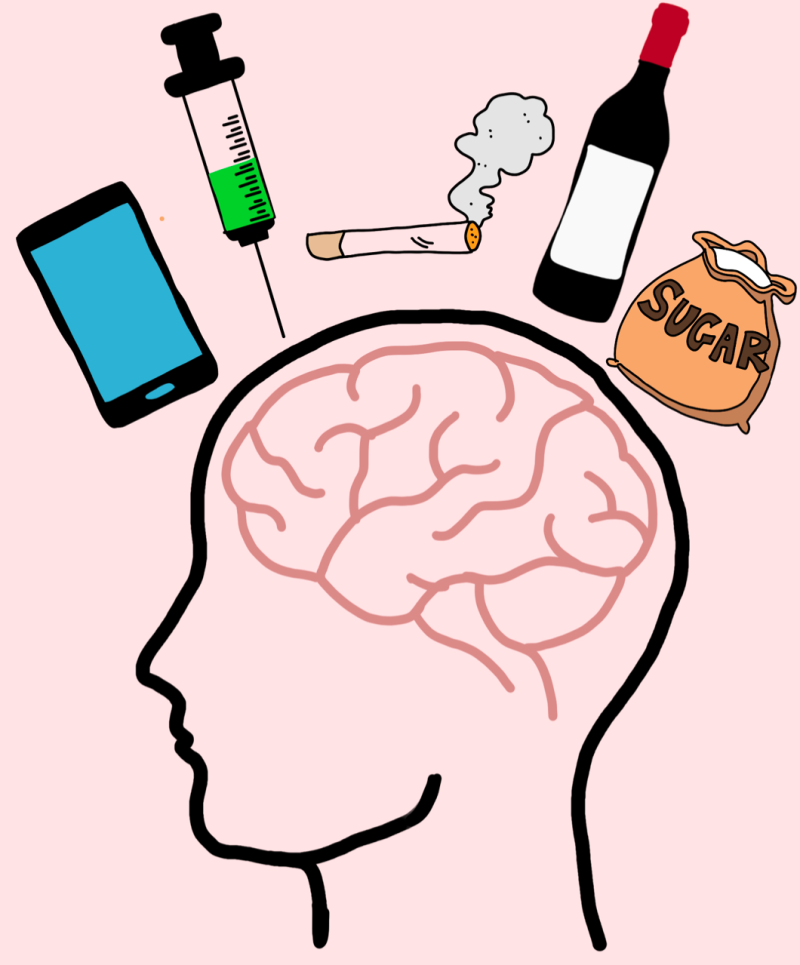Artwork by Olivia Pederson
What is Addiction?
In simple terms, addiction is a loss of control of drug use. The word “drug” doesn’t mean you can only be addicted to actual drugs. There are many things people can be addicted to such as, shopping, drinking, gambling, sex, social media, sugar, and the list goes on. The hot topic along with addiction is whether it is a choice or not to become addicted to a certain something. There are many people on either side of that topic but knowing all of the science and chemistry behind it is the only way to truly argue if it is a choice or not.
People see ‘addicts’ and assume that they have no self-control, no impulse control, and are untrustworthy. When looking at the science and understand just what is happening in the brain during this vicious cycle of addiction, we can see that is goes way further than just making a choice or simply getting short-term treatment.
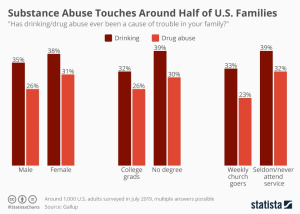 Statistically, over half of Americans have experienced some type of substance abuse problem within their families. This is only looking at alcohol and drug use, not taking into account the many other types of addiction families can struggle with. The statistics look a little different for recovery of addiction, but that will be talked about at the end.
Statistically, over half of Americans have experienced some type of substance abuse problem within their families. This is only looking at alcohol and drug use, not taking into account the many other types of addiction families can struggle with. The statistics look a little different for recovery of addiction, but that will be talked about at the end.
What is going on in the brain?
Specifically, the most common drugs of abuse are cocaine, heroin, and methamphetamines. These drugs all act by increasing the levels of dopamine in the brain. Dopamine has more to it than just being the “happy” chemical. It is responsible for motivation and reward, which is why an increase is so addictive because it is what the drugs of abuse are providing. These drugs of abuse happen to activate our reward pathway within the brain. This pathway includes the VTA and nucleus accumbens (NAc). Once a drug is taken and the pathway is activated and dopamine is increased the feeling will be reinforced within the brain. This will lead to people wanting to use over and over again to achieve this feeling or “high”.
 Addicts will choose this feeling over anything else in their life because eventually their brains don’t feel motivation or reward for any other activity other than using their drug of choice. Even with their drug of choice, they will eventually need to increase the amount they take to keep that high.
Addicts will choose this feeling over anything else in their life because eventually their brains don’t feel motivation or reward for any other activity other than using their drug of choice. Even with their drug of choice, they will eventually need to increase the amount they take to keep that high.
These drugs of abuse effect the brain much more than other types of natural rewards (food, social interaction). The brain is overwhelmed with the amount of dopamine that is being released because of the drugs, so it tries to adapt by reducing the amount of dopamine receptors on the neurons. This makes the brain less responsive to the drug but in turn decreases the brains natural reward system. After these changes, a person will need to take more drugs to get to the same level of high that they were at before building up their tolerance.
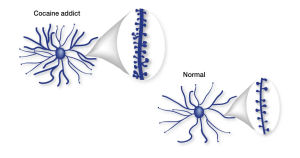 Part of the brain responsible for reason, judgment, learning, and memory begin to have changes as well. In some spots, the neurons are pruned back whereas in other regions there are more connections, completely changing the shape of the neuron. After all of these changes, the drug-seeking behavior becomes habit and the person becomes addicted.
Part of the brain responsible for reason, judgment, learning, and memory begin to have changes as well. In some spots, the neurons are pruned back whereas in other regions there are more connections, completely changing the shape of the neuron. After all of these changes, the drug-seeking behavior becomes habit and the person becomes addicted.
These changes to the neurons don’t just “go away” after the person quits the drugs of abuse. These changes can last for months or even years! The brain will not immediately return toward normal, which is why relapse and conditioning is an important factor that can effect successful recovery.
Role of Relapse and Conditioning:
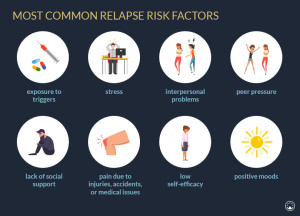 Relapse is defined as when a person returns to using drugs or alcohol after a period of sobriety. There are many factors that contribute to relapsing, which can be seen in this image. After the neurons are changed and the feeling and memories of drugs are implanted into someones brain it can be extremely hard to just give it up. The brain is still searching for this increased reward feeling and it isn’t getting it from ‘normal’ daily activities which can make turning back to drugs really tempting.
Relapse is defined as when a person returns to using drugs or alcohol after a period of sobriety. There are many factors that contribute to relapsing, which can be seen in this image. After the neurons are changed and the feeling and memories of drugs are implanted into someones brain it can be extremely hard to just give it up. The brain is still searching for this increased reward feeling and it isn’t getting it from ‘normal’ daily activities which can make turning back to drugs really tempting.
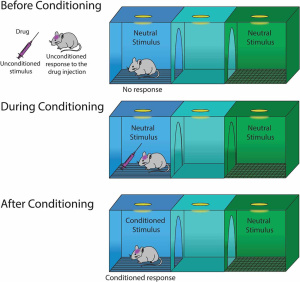 Conditioning is defined as a higher dose of drugs that can be tolerated when external stimuli is associated with prior administration of the drug is present. Basically, this means that if someone is doing drugs in the same room at the same time everyday they will eventually build up a tolerance because their brain will release the the effects of the drug before it is even taken. This leads to a tolerance, and if the drug is taken with any of the external factors changed it can lead to an overdose.
Conditioning is defined as a higher dose of drugs that can be tolerated when external stimuli is associated with prior administration of the drug is present. Basically, this means that if someone is doing drugs in the same room at the same time everyday they will eventually build up a tolerance because their brain will release the the effects of the drug before it is even taken. This leads to a tolerance, and if the drug is taken with any of the external factors changed it can lead to an overdose.
In the End:
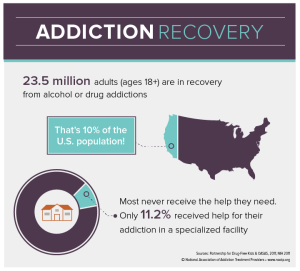 Recovery is much more complex than it is made out to be. There are many factors that play a part in the life of an addict. It is not as simple as quitting cold turkey sometimes. There are memories and outside factors that can effect the ability to remain sober. Being educated on all the facts of addiction can help stop the stigma that it is just a simple choice. It truly goes down to the cellular and molecular level and changes are happening at those levels making it difficult to change behaviors right away. Treatment for addiction can be very expensive and difficult. A lot of people are not even getting the help that they need because they are not sure where to even begin in their recovery journey, or they might not think it will even work. Every person is so unique and it can be hard to find the right treatment and the right length of treatment to fully recover. Also, returning to a routine can be difficult when the external factors are still a part of someones life. Patience and education is key when talking to someone with an addiction or talking to someone about addiction.
Recovery is much more complex than it is made out to be. There are many factors that play a part in the life of an addict. It is not as simple as quitting cold turkey sometimes. There are memories and outside factors that can effect the ability to remain sober. Being educated on all the facts of addiction can help stop the stigma that it is just a simple choice. It truly goes down to the cellular and molecular level and changes are happening at those levels making it difficult to change behaviors right away. Treatment for addiction can be very expensive and difficult. A lot of people are not even getting the help that they need because they are not sure where to even begin in their recovery journey, or they might not think it will even work. Every person is so unique and it can be hard to find the right treatment and the right length of treatment to fully recover. Also, returning to a routine can be difficult when the external factors are still a part of someones life. Patience and education is key when talking to someone with an addiction or talking to someone about addiction.
References:
naatp.org/addiction-treatment-statistics
learn.genetics.utah.edu/…tion/brainchange
pubmed.ncbi.nlm.nih.gov/16251986
statista.com/…/us-families-affected-by-substance-abuse
